Does Tax Code Really Matter?
The answer is “yes” and “no.” “Yes,” only if tax code affects GDP. Otherwise “no.”
In the study of supply-side economics, the Laffer Curve is postulated as follows:
The Laffer Curve implies that there is some point between zero and 100 percent that will maximize revenue. ... A more important lesson of the Laffer Curve is that there are always two tax rates that will collect the same revenue — a high rate on a small base and a low rate on a large base.
In graphic form, it looks like this:
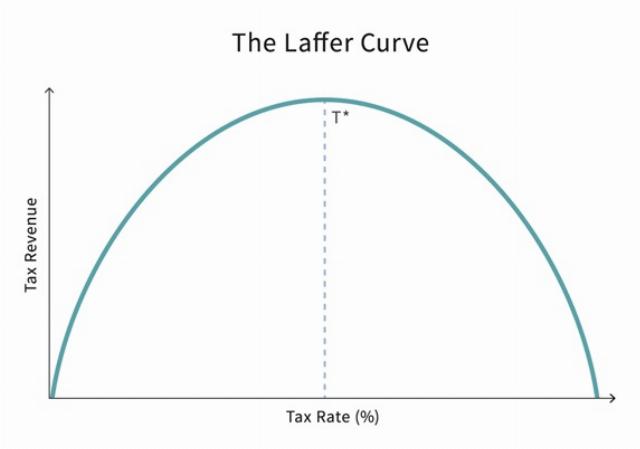
Implicit in the Laffer Curve is the idea that with zero taxation, people will keep all that they produce, so productivity and GDP would be at their peak. As you increase taxation, people are less incentivized to work hard just to pay more taxes, so GDP suffers as a direct correlation to taxation.
In a retail analogy, let us assume that the price of a hamburger is the tax rate, the number of hamburgers sold is GDP, and the net profit is federal revenue.
If it costs $1 to make a hamburger at your local fast food restaurant, and they sell it for $1, they make zero revenue, no matter how many are sold (the left side of the Laffer Curve). Say, then, that they sell that hamburger for $1.05, the cheapest in town. Yes, they’ll sell a lot of them, but people in the area have only a limited appetite for hamburgers (AKA the population), and they’ll maximize their sales at 1,000 burgers for the week, taking home $50 in profit.
Now sell that burger for $10.00. People have options, including to cook one at home with ingredients bought themselves for $2.00, so the restaurant might sell a dozen in a week, only to those who have zero time to cook and are hungry for a hamburger. Net profit: $108.
Lastly, they sell the burger for a competitive $2.00 (same cost as making one at home). They might sell 400 in that week because it’s so much easier and cleaner to pick one up at the drive-thru than to buy ingredients, cook, and clean up later. Net profit: $400. Increase or decrease the price a little, affecting a little, but profit remains essentially the same, representing the peak of the Laffer Curve.
Since the federal government formalized the federal income tax in the early 1900s, when government was still very small, federal revenue was small compared to our country’s GDP at less than 5%. During that time, most federal revenue came from customs duties and excise taxes. That changed in the 1930s, when federal government exploded in growth under the Hoover and Roosevelt administrations trying to grapple with the Great Depression, which raised the top marginal income tax rate up to a peak of 79 percent.
Receipts surpassed 10% of GDP in the early 1940s and by late 1940s began stabilizing at about 17%. Since then, federal revenue remains stubbornly at 17% plus or minus a standard deviation of 1.6%.
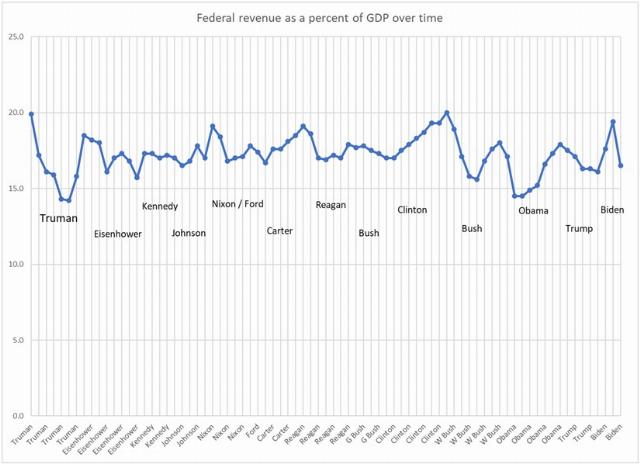
The following analysis is derived from numbers published by the Brookings Institution. Unfortunately, we must leave out the Trump and Biden administrations because Trump was cursed in his final year with economic collapse due to COVID shutdowns, for which Biden takes credit for “economic growth” when in fact it was just America getting back to normal.
Looking at net federal tax receipts (corrected by inflation to 1945 dollars) in various recent administrations reveals nothing terribly remarkable except for blips during the Bush and Obama administrations. The trend is otherwise nearly linear, as shown by the dotted trend line.
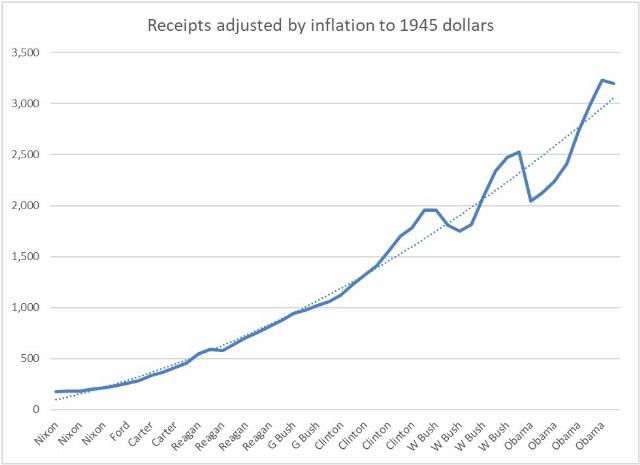
What is more interesting is to look at GDP growth during each administration and how it compares to receipts and the ratio of federal receipts to GDP.
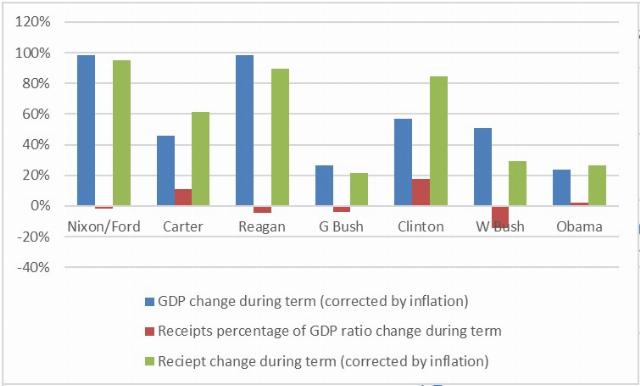
In every Democrat administration, receipts as a percentage of GDP grew positively, whereas in every Republican administration, they went negative. This is not surprising, as Democrat policy consistently wants to take more dollars from the economy (GDP), whereas Republican policy wants to leave it in your pocket to spend as you will. Obviously, there are many other influencing factors that have driven the economies during each administration, but the patterns over time are clear.
What is also evident is that GDP growth has no demonstrable correlation to receipts as a percentage of GDP, which, as stated earlier, reflects Democrat versus Republican tax policy.
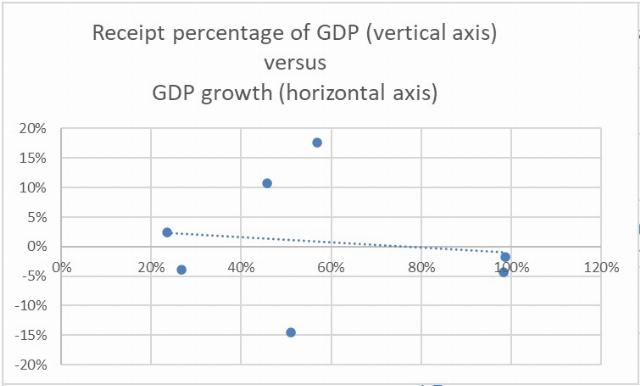
In science, drawing no correlation is just as important as drawing a perfect correlation among variables. The “so what” here is that the lack of any solid direct correlation of federal revenue versus Democrat or Republican administrations and corresponding tax code most likely indicates that we are somewhere in the middle of the Laffer Curve, where small changes in tax code are inconsequential on revenue. Therefore, the notion that proposed tax cuts “must be paid for” is complete nonsense.
On the other hand, the other “so what” is that federal receipt increases correlate most strongly with GDP increases, which make GDP growth the most important variable to sustaining and maximizing federal revenue to keep Social Security and Medicare solvent and to maintain our strong military.
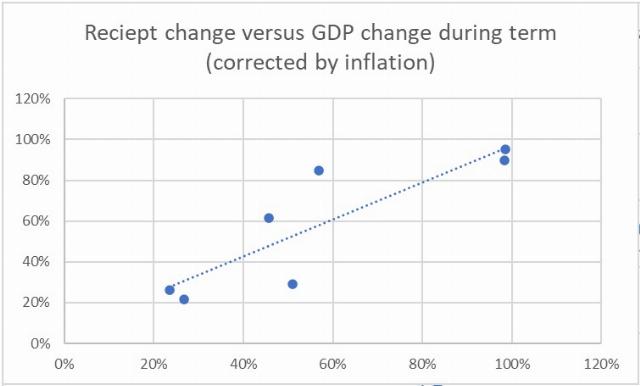
This is the “big picture” conversation we must be having about tax codes: what will ultimately make a positive difference on GDP, not what will inconsequentially suggest adding a few more pennies to the D.C. coffers.
Trump knew this, because he personally understands what creates GDP, which is why he is the right man for the job to save this country from imminent bankruptcy. Unfortunately, his time was cut short (also by COVID). To experience the full effect of Trump policies of deregulation and tax code incentives for long-term GDP growth and its effect on both the economy and the health of the social programs now otherwise headed for bankruptcy, we will have to re-elect him. I hope and pray we will have that chance in 2025 and beyond.

Money image via Pixabay. Pixabay License.
FOLLOW US ON
Recent Articles
- Deep Dive: The Signal Chat Leak
- Mark Steyn’s Reversal of Fortune
- Where We Need Musk’s Chainsaw the Most
- Trump Is Not Destroying the Constitution, but Restoring It
- The Midwest Twilight Zone and the Death of Common Sense
- Hijacked Jurisdiction: How District Courts Are Blocking Immigration Enforcement
- Transgender Armageddon: The Zizian Murder Spree
- Jasmine Crockett, Queen of Ghettospeak
- The Racial Content of Advertising
- Why Liberal Judges Have a Lot to Answer For
Blog Posts
- Amid disaster, watch Bangkok clean up and rebuild
- Katherine Maher shoots herself, and NPR, in the foot
- A visit to DOGE
- You just might be a Democrat if ...
- Yahoo Finance writer says Trump’s tariffs will see America driving Cuban-style antique cars
- Kristi Noem and the prison cell
- Dividing the Democrats
- April 2nd: Liberation Day and Reconciliation Day don’t mix
- Red crayons and hospital gowns
- The Paris Climate Agreement was doomed from the start
- Well excuse me, I don't remember
- Bill Maher goes civil
- Mass shootings: we're all survivors!
- Tesla and a second
- Snow White: a bomb for the ages






